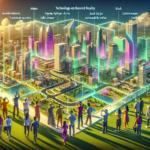AI-Powered VR: The Future of Gaming with Meta and NVIDIA
Imagine a world where gaming isn’t just immersive; it’s intelligent and dynamically responsive. With the potential collaboration between Meta and NVIDIA, we may soon see a revolutionary step in the gaming industry through the development of an AI-powered VR game engine. This innovation could change how we interact with virtual environments and elevate the gaming experience to unprecedented heights.
The Synergy of Two Tech Giants
When Meta, known for its groundbreaking VR hardware through the Meta Quest series, joins forces with NVIDIA, famous for its state-of-the-art AI and graphic technologies, the possibilities become boundless. This collaboration stands to reshape the landscape of VR gaming, combining their respective expertise to deliver stunning and captivating experiences.
NVIDIA’s Omniverse Platform
NVIDIA’s Omniverse platform serves as an exceptional catalyst for real-time collaboration and simulation. This versatile platform allows designers to work flexibly in shared virtual spaces while utilizing tools like Maya, Blender, and Autodesk. Integrating Meta’s VR capabilities with the Omniverse could empower developers to create games that are not only visually breathtaking but also immensely interactive and collaborative.
Real-Time Rendering Meets AI-Driven Graphics
At the core of this AI-powered VR game engine lies the ability to produce lifelike graphics in real-time. By leveraging NVIDIA’s RTX technology and the Universal Scene Description (USD) format, games can achieve photorealistic visuals, further enhancing immersion in VR experiences.
AI-Powered MetaHumans for Enhanced Interactivity
Now, imagine designing AI-powered MetaHumans seamlessly integrated with NVIDIA’s ACE (Automated Character Engine). With this generative AI technology, developers can create realistic human characters that dynamically react and interact with players in authentic, engaging ways, thereby adding a new layer of depth to the VR experience.
Strengthening Collaboration in Virtual Reality
The essence of innovation lies in collaboration. NVIDIA’s Omniverse offers real-time collaborative tools, allowing multiple players and developers to engage effortlessly in a shared virtual landscape.
Creating Interactive Virtual Workspaces
Using advanced tools like UME.Studio, teams can collaborate live and contribute to the same project simultaneously. This dynamic approach fosters creativity, reduces development inefficiencies, and ultimately enhances the quality of games produced.
Integrating 5G and Edge Computing for Seamless Play
To further elevate the AI-powered VR gaming experience, integrating 5G technology alongside edge computing proves essential. Recent tests, such as those conducted at Hyperbat, demonstrate how 5G-enabled VR headsets can ensure minimal latency and reliable connections, allowing smooth interactions within virtual environments.
Harnessing CloudXR and RTX Virtual Workstation
NVIDIA’s CloudXR and RTX Virtual Workstation software are game-changers, enabling rapid data processing on remote systems. This capability ensures that gamers experience an uninterrupted and smooth journey even in complex, data-heavy games.
Transforming the Game Development Landscape
The partnership between Meta and NVIDIA wouldn’t just alter gameplay but redefine how developers create games. Here are several promising changes we might anticipate:
Real-Time Feedback for Swift Iterations
Imagine developers testing and fine-tuning their games instantly within a virtual environment. By enabling immediate feedback and adjustments, the game development cycle could become much more efficient, resulting in higher-quality products.
Crafting Photorealistic Game Worlds
Thanks to NVIDIA’s real-time rendering, game designers can now cultivate environments with astonishing realism. This enhancement increases immersion, transforming gameplay into an experience closely resembling the real world.
Dynamic and Interactive Characters
Equipping games with AI-driven characters brings a new layer of interactivity. Players would engage with characters capable of thoughtful, dynamic responses, crafting a truly captivating experience.
Envisioning the Future of AI-Powered VR Gaming
A real-time VR game engine powered by AI, stemming from a Meta and NVIDIA collaboration, signals a thrilling future for the gaming world. Here are some exciting anticipations:
Creating Unforgettable Immersive Experiences
Players can expect not just visually stunning games but also engaging and responsive gameplay. The mix of real-time rendering, intelligent AI characters, and seamless collaboration sets the stage for an unparalleled immersive adventure.
Innovating Business Models
This technological leap could usher in new business models like subscription services for premium VR content or virtual reality esports leagues, where players compete in hyper-realistic environments.
Diverse Applications Beyond Gaming
The implications of this technology stretch far beyond gaming itself. Potential applications in education, healthcare, and engineering could prove transformative. For example, medical students might practice complex surgeries in hyper-realistic VR settings, while engineers could design and test intricate systems in versatile virtual spaces.
A collaboration between Meta and NVIDIA promises a monumental transformation in the realm of gaming and beyond, merging cutting-edge VR technology and AI prowess. By laying the groundwork for unparalleled experiences, this partnership paves the way for groundbreaking advancements in virtual reality.




0 Comments